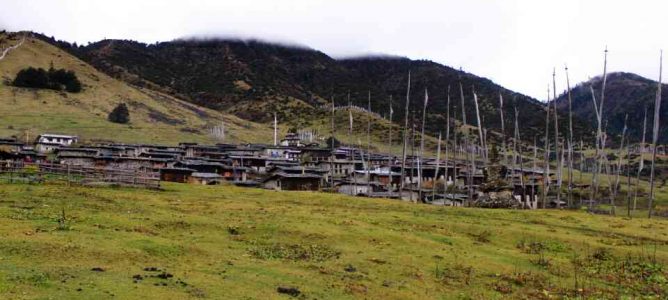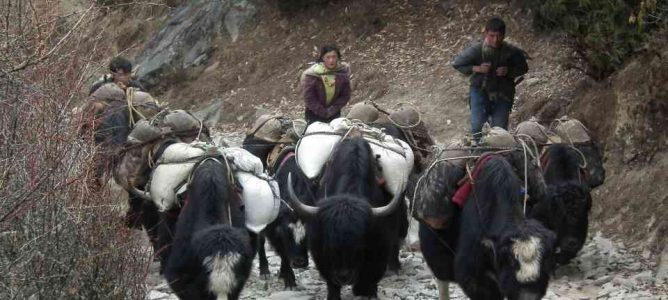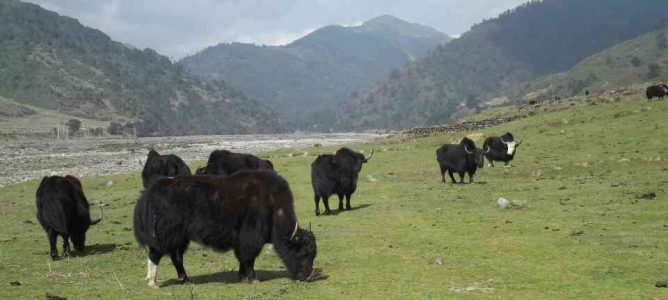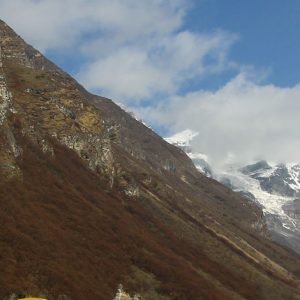Day 1: ARRIVE AT GUWAHATI INTERNATIONAL AIRPORT – SAMDRUP JONGKHAR (L/D)
Upon arrival at Guwahati International Airport in India, you will be met by an English speaking representative. Then it is about a three hour drive to Samdrup Jongkhar in Bhutan. After lunch, explore the border town of Samdrup Jongkhar town as well as go across the border to the Indian town of Mela Bazar.
Dinner and overnight at your hotel in Samdrup Jongkhar.
Day 2: SAMDRUP JONGKHAR – NELANG – RADINGPHU (B/L/D)
After breakfast, it is a one hour drive to Nelang from where your trek begins. It is then a 4 hour walk from Nelang to Radhing. En route, visit Choki Gyatsho Institute at Dewathang established by His Eminence Dzongsar Khyentse Rinpoche.
From Nelang, walk downhill for about 45mins till you reach the Duri River formed by three streams namely Phudungri, Menchari, Morongri. Once you reach Duri, the trek follows the river on a straight stretch for about two hours and we will halt at Dutktseri for lunch. One of the significant aspects of this stretch is that trekkers have to criss-cross the Duri River seven times on traditional log bridges before reaching Dutktseri which is our designated lunch point.
After lunch the trek follows the Duri River for another two hours and again you will have to criss-cross the river six times on traditional log bridges before reaching Radingphu – a perfect halt for the night. Radingphu is a vast flat area with water facilities readily available. This is an ideal place for visitors who are interested in swimming or at least taking a splash in the river.
Dinner and overnight camping at Radingphu.
Day 3: RADINGPHU – MONGLING (B/L/D)
From the base camp at Radingphu, there is a steep 3 hour climb to reach Dotak where visitors can halt for lunch. Dotak is situated on the border between the Pema Gatshel and Samdrup Jongkhar districts.
After lunch the trek follows a steep climb for another two hours until we reach Mongling. On the way there is a place called Zerim which is a flat grassy place shrouded by broad leaved tress. From Zerim you will be treated to a beautiful bird’s eye view of the Dewathang valley. From Zerim, the trek climbs slowly for about one hour and then it follows a straight stretch until you reach Regonpo on the base of the Yonglaphu. There is a small spring close by at Regonpo. From Regonpo the trek is level till we reach Mongling on the Tshelingkhor-Pemagatshel highway, which is an ideal location to rest for the night. If you wish to continue onwards and travel to Demrizam for the night you can drive there via the farm road. It is a one hour drive from Mongling to Demrizam. It takes about 5 hours to climb from Radhing to Mongling.
Dinner and overnight camping at Mongling.
Day 4: MONGLING – DEMRI ZAM (B/L/D)
The satellite town of Kheri Gonpa is half an hour’s drive from Mongling. From Mongling you get a beautiful view of some part of Pema Gatshel and Dewathang. The stretch between Mongling to Demri Zam is a slow descent crossing a farm road several times. From Mongling, you can visit Yongla Gonpa. Yongla Gonpa observes its annual religious ceremony known as Jali Phurba presided over by Yongla Lama (Abode of Yongla). The religious ceremony is accompanied by mask dances and folk dances performed by both monks and laymen. The other religious site to visit is the Jangchub Chorten constructed by Rangshikhar Lama.
Dinner and overnight camping at Demri Zam.
Day 5: DEMRI ZAM – DENCHUNG (B/L/D)
Demri Zam was the place where traders traditionally stopped to rest for the night. Water is readily available and the river provides an ideal place to enjoy some swimming and fishing. If you are interested, we can arrange permits for fishing.
The next day the trek ascends slowly until you reach Tsathsi Danri for a lunch break. After lunch we will begin a steep descent to the Tonglingdrang Suspension Bridge. From here on it is a gradual ascent and generally level to Denchung by the side of the Khaling River, where we will camp for the night.
Dinner and overnight camping at Denchung.
Day 6: DENCHUNG – CHEYA (B/L/D)
From Denchung the trek follows the Khaling River for a little more than two hours where we reach Liza for lunch. After lunch the trek follows a steep ascent through beautiful pine forests until we reach Cheya. The stretch from Denchung to Cheya will probably be the most difficult section of the trek as the path climbs steeply. The campsite at Cheya is very beautiful as it is located near the Cheya Tsho (Lake) from which water is readily available. Today’s trek takes about 5 hours.
Dinner and overnight camping at Cheya.
Day 7: CHEYA – TRASHIGANG (B/L/D)
The last day of the trek will be from Cheya to Trashigang. There are two options: you can either ride to Trashigang from Cheya via Khengthongmani or you can trek from Cheya to Khengthongmani and then take a ride from Khengthongmani.
Then visit Trashigang Dzong which is on a high promontory that overlooks the confluence of the Drangme Chu (River) and Gamri Chu. It was built in 1667 by Chogyal Mingyur Tempa, Bhutan’s third Desi (Governor).
Dinner and overnight at your hotel in Trashigang.
Day 8: TRASHIGANG – MONGAR (B/L/D)
After breakfast, drive to Mongar. In the evening, visit Mongar Dzong. This dzong was rebuilt in 1953 and is quite small. There are around 50 to 60 monks in the dzong, many of them are young boys around eight to ten years old. In the dzong there is an image of the Buddha of long life as well as one of the Guru Rimpoche (who brought Buddhism to Bhutan).
Dinner and overnight at your hotel in Mongar.
Day 9: MONGAR – BUMTHANG (B/L/D)
After breakfast, drive to Bumthang via Ura.
Dinner and overnight at your hotel in Bumthang.
Day 10: BUMTHANG – SIGHTSEEING (B/L/D)
After breakfast, visit Me-bar Tsho (Burning Lake) and Tamshing Lhakhang.
In the afternoon, visit Jambay Lhakhang, Kurje Lhakhang, and Kenchosum Lhakhang and also visit the Jakar Dzong, built by Chogyal Minjur Tempa, the 3rd Desi in 1646 AD.
Dinner and overnight at your hotel in Bumthang.
Day 11: BUMTHANG – THIMPHU (B/L/D)
After breakfast, drive to Thimphu.
Dinner and overnight at your hotel in Thimphu.
Day 12: THIMPHU – PARO (B/L/D)
After breakfast, we will drive to Dodeyna to climb through a beautiful forest track to the Tango Monastery which overlooks a forested valley and other Buddhist retreats high in the mountains. Then we visit the National Memorial Chorten built in honour of Bhutan’s late King Jigme Dorji Wangchuck before visiting the Giant Sakyamuni Buddha statue atop Kuensel Phodrang, the mini zoo at Motithang to see the Takin, Bhutan’s national animal.
In the evening, visit Tashichho Dzong, seat of the national government and the Central Monastic Body which includes the summer residence of the Je Khenpo (Chief Abbot of Bhutan). If you wish we can then visit the Handicrafts Emporium followed by shopping for souvenirs and other items in the shops of Thimphu.
Later in the evening, we will drive through to Paro.
Dinner and overnight at your hotel in Paro.
Day 13: TAKTSANG MONASTERY OR TIGER’S NEST (B/L/D)
After breakfast, we will drive you to the trail head to commence a climb through beautiful pine forest. We will stop for light refreshments at the Taktsang cafeteria before walking on to the famous, Taktsang monastery or Tiger’s Nest. The primary Lhakhang or main temple was built around Guru Rimpoche’s meditation cave in 1684 by the Penlop of Paro, Gyalse Tenzin Rabgay. This incredible monastery clings to the edge of a sheer rock cliff that plunges 900m into the valley below. Legend has it that Guru Padmasambhava, the tantric mystic who brought Buddhism to Bhutan in 747 AD, flew here on the back of a flying tiger, Dorji Drolo from Kurtoe Singye Dzong in the east.
After lunch, we will visit Drugyal Dzong (a ruined fortress), 16 km away from Paro. Although it is now in ruins, this dzong has great historical importance for the people of Bhutan. It was a place where the Bhutanese finally defeated the Tibetan invasion. On a clear day one can view sacred Mt. Jhomolhari (Mountain of Goddess). We will also visit Ta Dzong (built in 1656 and renovated in 1968), an ancient watchtower, which now houses the National Museum. Below the museum is the Rinpung Dzong (literally meaning “Heap of Jewels”), the centre of civil and religious authority in this valley, built in 1646 by Zhabdrung Ngawang Namgyal.
Dinner and overnight at your hotel in Paro.
Day 14: PARO – PARO INTERNATIONAL AIRPORT (B)
In the morning drive to Paro International Airport where your guide will accompany you to bid you farewell.

















Reviews
There are no reviews yet.